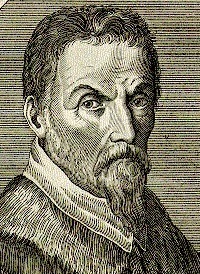Cesare Cremonini (philosopher) facts for kids
Quick facts for kids
Cesare Cremonini
|
|
|---|---|
 |
|
| Born | 22 December 1550 |
| Died | 19 July 1631 (aged 80) |
| Era | Renaissance philosophy |
| Region | Western philosophy |
| School | Aristotelianism Averroism Scholasticism |
|
Main interests
|
Metaphysics, astronomy, medicine |
|
Notable ideas
|
Mortality of the soul, separation of reason and faith |
|
Influences
|
|
|
Influenced
|
|
Cesare Cremonini (born December 22, 1550 – died July 19, 1631) was an Italian professor. He taught about nature and the world using rationalism (which means using reason and logic). He also followed the ideas of Aristotle, believing that the soul was not separate from the body and died with it. This was different from many people who believed the soul lived forever.
Cesare Cremonini was seen as one of the most important thinkers of his time. He was supported by powerful leaders like Alfonso II, Duke of Ferrara. Kings and princes even had his picture and wrote letters to him. He was paid twice as much as Galileo Galilei, another famous scientist. Today, he is mostly remembered for his part in the Galileo affair. He was one of two scholars who refused to look through Galileo's telescope. Cremonini said he had looked through one before, but it made him dizzy. He thought only people with strange eyesight could see what Galileo claimed.
Biography
Cesare Cremonini was born in Cento, which was part of the Papal States back then. He taught about nature and the world for about 60 years.
- From 1573 to 1590, he taught at the University of Ferrara. He started teaching at a very young age. People saw him as a great talent. He received support from Alfonso II, Duke of Ferrara. Cremonini dedicated his first big book to him in 1596. Other teachers became jealous of this special treatment. This led him to take a job in a different area.
- From 1591 until he died, he taught at the University of Padua. This city was then part of the Republic of Venice. He took over from Jacopo Zabarella. He held positions in both natural philosophy and medicine.
He taught the ideas of Aristotle. He especially focused on how Aristotle's ideas were explained by other thinkers like Alexander of Aphrodisias and Averroes.
Cremonini was very popular during his lifetime. Many kings and princes had his portrait. They also wrote to him, sometimes asking for his advice. At Padua, his salary was twice as much as Galileo's. French thinkers especially liked him. They called him "le Cremonin" (the Cremonin). Even a writer named Jean-Louis Guez de Balzac called him "the great Cremonin."
Cremonini and Galileo
At the University of Padua, Cremonini was both a rival and a friend to his fellow professor, Galileo. In 1610, Galileo announced he had found mountains on the Moon. He offered Cremonini a chance to see this proof through his telescope.
However, Cremonini refused to even look through the telescope. He insisted that Aristotle had already proven the Moon was a perfect, smooth sphere. Later that year, Galileo decided to move to Tuscany. Cremonini warned him that moving there would put him under the power of the Inquisition. The Inquisition was a powerful church court.
Years later, Galileo wrote a book called Dialogue Concerning the Two Chief World Systems. In this book, Galileo included a character named Simplicio. This character was a stubborn follower of Aristotle's ideas. Simplicio was partly based on Cremonini.
Death and legacy
Cesare Cremonini died in 1631 during a terrible outbreak of the Italian Plague of 1629-1631 in Padua. At the time of his death, more than 400 students were studying with him. Many of his former students became famous in their own fields.
Some of his notable students included:
- William Harvey, who graduated in 1602. He was an English doctor. He was the first person to correctly explain how blood circulates in the body.
- Joachim Jung, a German mathematician and naturalist.
- Gabriel Naudé, a French scholar and librarian.
Cremonini was buried in the Benedictine monastery of St. Justina of Padua. He also left his belongings to the monastery in his will. Today, several streets are named after him. These include "via Cesare Cremonini" in Cento and "via Cesare Cremonino" in Padua. An institute in Cento, "Istituto Magistrale Cesare Cremonini," also carries his name.
See also
 In Spanish: Cesare Cremonini para niños
In Spanish: Cesare Cremonini para niños

